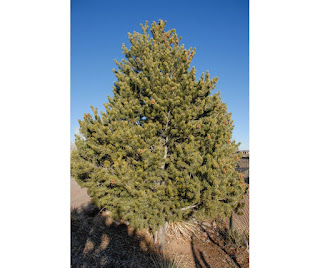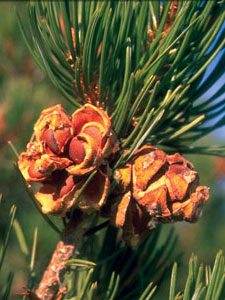by Amy Lentz, CSU Extension Horticulture Agent- Weld County
Even with recent snowfalls, many of us are still in some sort of drought in Colorado. It’s been unseasonably dry over the past fall and winter so far and our trees could suffer if they don't get moisture during these dry winter months. We've talked before about the importance of winter watering, but I also wanted to take a moment to cover just a few evergreen trees that can better withstand drier conditions, whether you create those conditions through xeriscaping or you just want to choose the right evergreen tree for your dry location.
Pinyon pine (Pinus edulis)
 |
| Pinyon pine tree. Photo by Colorado Springs Utilities Xeriscaping. |
This is a great option for those living along the Front Range and lower elevations and if you are dealing with a steep slope where water runs off frequently. However, they don’t like to be wet, so placing a Pinyon pine in the middle of your lawn where it gets watered three times a week is not ideal and the tree will likely suffer. It’s a smaller evergreen tree with two needles per bundle and attractive smaller cones. These cones are where we get pine nuts!
 |
| Pinyon pine cones. Photo by Colorado State Forest Service - Colorado State University. |
Bristlecone pine (Pinus aristata)
 |
Bristlecone pine tree. Photo by Oregon State University. |
Bristlecone pine is a unique tree with a smaller mature height of around 20 feet tall with short, dark green needles that have tiny white resin dots on them (and often mistaken for bugs). Once you see past the dots, you will notice that this tree has a nice form and holds its needles for several years. This tree also grows very slowly, so you can even use it on your front porch in large containers until you are ready to plant it in the ground.
 |
Bristlecone pine needles. Photo by Oregon State University.
Rocky Mountain juniper (Juniperus scopulorum)
 |
Rocky Mountain Juniper Trees. Photos by Oregon State University.
This is one tough tree! Rocky Mountain junipers are often utilized in the worst conditions, like a windbreak on the Northern plains where the wind never stops. They are pyramidal in shape and small in mature height, reaching around 15 feet, depending on what type you choose. The overall color of these trees can range from green to blue, again depending on the cultivar. Look to your local nurseries to find specific cultivars such as 'Wichita Blue', 'Woodward' or 'Cologreen'.
The list of good evergreen trees for dry sites doesn’t stop
with this blog, there are plenty from which you can choose. For a more complete
list of all evergreen trees for Colorado landscapes (including those or more moist
sites), check out our CSU Fact Sheet #7.403 - Evergreen Trees.

Great topic. Go with native!
ReplyDeleteThere are many other native and nonnative conifers that have proven to do amazingly well in dry conditions (once established), including Ponderosa pine, single-needle pine, Bosnian pine, dwarf mugo pine, and dwarf Jack pine. The Arizona cypress varieties being grown locally are also super drought tolerant as well as cold-hardy and offer gorgeous blue color all year long.
ReplyDeleteWhen it comes to evergreens don't forget the various Cercocarpus species as well as manzanitas.